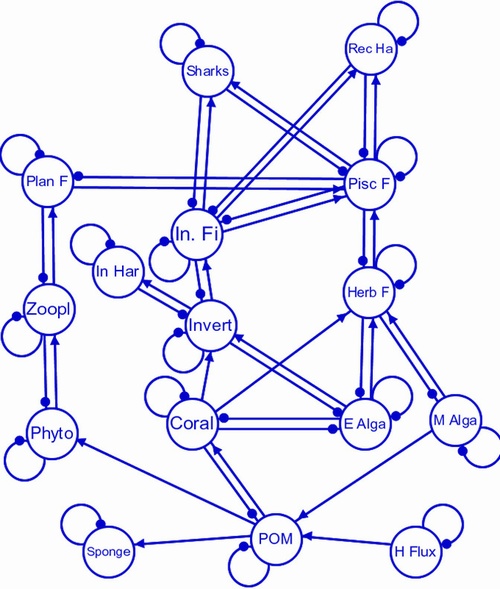Australia's top models are going to be on the main stage in Cairns this week but don't get too excited. They're only here to show new ways to understand climate change, improve air safety and enhance agricultural sustainability - the small stuff unless you care about life as we know it. Fortunately, these numerical models understand those things much better than actual supermodels.
The gathering is the IMACS/MODSIM Congress and will attract more than 650 experts in modelling and simulation from Australia and overseas to the Cairns Convention Centre from July 13-17, 2009.
CSIRO Mathematical and Information Sciences chief and Congress speaker Dr Louise Ryan said mathematical models are ways of describing the actions of very complex natural and man-made systems by quantifying how their key components interact.

Australia's top models will not include Elle MacPherson. It will include this reef ecosystem model:

Credit: CSIRO
"Take a simple food chain we might learn about at school – plankton are eaten by small fish, who are eaten by bigger fish like tuna which are caught for our dinner," Dr Ryan said. "In a real ecosystem, hundreds or even thousands of species interact - and not just as predators and prey.
"In the US, I worked on a model of how mercury from coal-fired power stations moves through a real food chain - from its release into the atmosphere and then into the water where it's absorbed by plankton and all the way through to humans. By painting a detailed mathematical picture of how different parts of the system affect each other, the model could predict what would happen to peoples' mercury levels, for example, if emissions levels were reduced in a nearby power plant."
Other top models at the conference include:
- assessing current and future water availability in four of Australia's major water systems, including the Murray-Darling Basin, Northern Australia, South-West Western Australia and Tasmania
- making the skies safer by predicting the safest distances between different types of aircraft both in the air and at airports, and so form a basis for reliable rules for pilots and air traffic controllers
- evaluating whether increased coral bleaching on Australia's Great Barrier Reef due to climate change will substantially impact the tourism industry and whether improved agricultural practices could improve water quality enough to mitigate this.
Ryan said that a good computer model of a complex ecosystem might be built on decades worth of data and expert knowledge about the underlying biological or physical system.
"The better the data a model is based on, the more reliable it is at predicting changes and guiding real decisions. No model is perfect, but it doesn't need to be to do a good job of predicting. Knowing how complicated a model needs to be is where the art of modelling lies" she said.
Co-Chair of IMACS/MODSIM ANU Professor Tony Jakeman said the conference is attracting a wide range of scientists who use modelling and simulation, such as hydrologists, physicists, climate scientists, economists and other social scientists, statisticians, image analysts, and software engineers.
"What we learn from one area is often applicable in another," said Jakeman.
"The underlying maths can be almost the same. Conferences like this are a great opportunity to find out what others are doing and get some new ideas to discuss and try out. That's how science moves forward" he said.
The conference sponsors include CSIRO, the Queensland and Victorian governments, Griffith University, the Australian Mathematical Sciences Institute and the eWater CRC.


